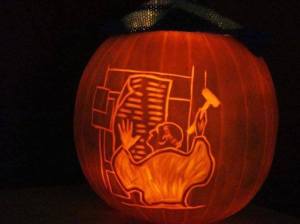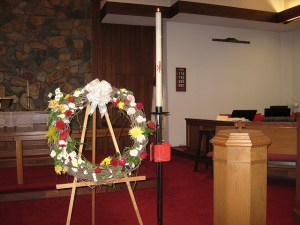
All Hallows’ Eve, more commonly known as Halloween, is an important time for us Lutherans (and the entire Church, I might add). Yes, on October 31, 1517, good old Martin Luther posted his 95 Theses critiquing practices and teachings related to indulgences.(1) It was good – and likely not coincidental – timing. The Church was thinking about matters of death and resurrection.
Indeed, the harvest was ending. Plants were dying or growing dormant. Hunting became harder as animals became scarce due to migration or the movement into hibernation. The season was growing darker and days shorter. People’s minds in these more superstitious days could turn to some very dark things. As a television show popularized, they would sense, “Winter is coming” in the worst sense. Death seemed afoot with demons, goblins, and ghosts to boot.
Pagan cultures for centuries had used this time of year to remember the dead and dark things, especially those who might still be walking or floating around them. As Christianity supplanted paganism, people did not really change. Many of the fears remained the same. Not everyone trusted that Jesus had fully defeated death, at least where they were concerned. It seemed reasonable and likely that more suffering was to come as people they loved transitioned into the afterlife.
In this context, people strained to make sense of it all. Drawing from some dubious scriptural citations and some very creative thinking, people expected they would never be good enough to merit heaven. The idea of limbo and purgatory – places where those not ready or quite good enough for heaven could be purged of sin and maybe one day enter heaven after much suffering – came into the fore. Hell caught more and more of the common folk’s attention, as heaven seemed more and more unattainable. They feared God’s judgement in a world where many died before thirty years of age. The world was a frightening place, and God seemed distant, angry and terrifying.
So, the Church tried as it could in those times to respond to (and within) that worldview. Although there certainly were early practices honoring saints and imploring divine help and mercy for the dead, one can trace a more significant line toward today’s practices. On 13 May 609 or 610, Pope Boniface IV consecrated the former Pantheon at Rome to become a Christian shrine, Our Lady and the Martyrs. He is believed to have chosen this date to witness against and supplant the ancient, Italian pagan feast of the Lemuria. The Lemuria was celebrated on three days — May 9, 11, and 13. Even days were considered unlucky by the Romans. The day honored the dead and particularly the lemures, the unfriendly if not dangerous spirits of people who died violent or untimely deaths. Pope Boniface IV ordered a celebration should be held every year.
In a similar fashion, sources indicated that Pope Gregory III dedicated a worship space in Old St. Peter’s Cathedral to venerate relics of saints, martyrs, and the Apostles of the Church on November 1, 731. This, too, was to be remembered each year with festival worship. By the late 8th Century, a practice to remember the saints and martyrs also grew seperately in what is now the British Isles and Ireland as the Church fought back popular Celtic pagan practices related to remembering the dead. A Northumbrian abbot, Alcuin, whether reflecting upon events in Rome or perhaps something else, argued alongside others that an annual remembrance and celebration should occur every November 1. At the insistence of Pope Gregory IV and other religious leaders, the Holy Roman Emperor, Louis the Pious, finally decreed November 1 would become a “day of obligation” in 835.(2) Failure to attend worship would risk one’s salvation and perhaps result in fines or punishment. By the 12th Century, the 13 May celebration had been supplanted by the November 1 saintly celebration and its accompanying October 31 vigil services.
It was easy in those days to assume the “perfect” and holy saints might be with God, but what about our family members who, well, we knew not to be so perfect or even “bad”? In the 13th Century, All Souls’ Day became a companion observance on Novmber 2 to remember all those still in pergatory. All Saints’ Day remained a day to recognize the exulted few. Also known as the Commemoration of All the Faithful Departed and the Day of the Dead, All Souls’ Day is specifically meant to be about prayer and remembrance for the souls of these still suffering, baptized members of the Church. (3)
All the while as these litrugical practices developed, amidst the ravages of the plague and on and off again wars in Europe, things became more frightening. Coffers became emptier. The Church began to seek funds through the selling of indulgences. Indulgences were like a “get out of Purgatory free card,” a way to reduce the amount of punishment one had to undergo for their sins.(4) In other words, one could pay for oneself or one’s family members (even those already dead) to be released earlier from purgatory, and you received a paper that said so. Looking upon the mass as a sacrifice, people could also pay for masses to be said to help their dearly beloved departed. Each mass paid for meant less time suffering. Under the auspices of “the keys” (Matthew 16:19), believed to be a hereditary power gifted to those succeeding St. Peter as bishop of Rome, Popes began to use that power to their advantage and disgrace. The money would build a new cathedral in Rome, but it also fueled a growing corruption in the western Church.
On October 31, 1517, in walked a college professor, a Bible scholar, theologian, and Augustinian Monk, named Martin Luther. He posted his 95 Theses, or Disputation on the Power and Efficacy of Indulgences, against these abuses in the hope of sparking discussion and reforms. The day he chose to do this was the Vigil of All Hallows (or now, All Saints’) Day, also originally called All Hallows’ Eve (now Halloween to most people). The Church was remembering Christ’s victory over sin, death, and the Devil. It was celebrating the freedom his faithful followers had been gifted. What a perfect time to assert, “When our Lord and Master Jesus Christ said, ‘Repent’ (Mt 4:17), he willed the entire life of believers to be one of repentance.” He went on to argue ninety-five theological points that the process of repentance (a turning back toward God) and frogiveness of sin should not be about money or based on fear. Martin Luther had come to believe our loving God has already freed us in love through what Jesus had done and promised. If the Papal authorities really had the power to forgive sin, why not do so out of love? In response to Christ’s sure promises, we are invited to trust and reorient our life toward God and others in love – in thanksgiving not fear. We can run back to God for foregivenss over and over agains without fear. We can walk on through tribulations, punishments and even hell itself with confidence. Our battle is already won by Jesus, and death has lost its sting. This good news turned into what we know today as the Reformation.
Foot notes:
(1) Some scholars suggest that Martin Luther did not nail his 95 Theses to any door, but instead, they argue he only mailed (“posted”) it. Yet, I would argue to accept that he mailed something does not necessarily exclude the possibility that he also (or only) posted/nailed/tacked something on to the door of the university church. He we are in the 21st century, and I still see occasional missives posted on or near the nearby university – much as I did in the 2000s and 90s. I’ve seen this behavior in other countries as well. I’m not so fast to give up on pervasive social memory. I’ve seen “stories” discarded as myth as told by Native Americans and others, and then someone goes and discovers something proving the story holds some truth. Anything is possible. Indeed, in the early 1600s, he was depicted writing them on the door with a quill. Here’s an article from the Washington Post (2017) that might help explain this still unsettled debate – to often presented as fact: https://www.washingtonpost.com/news/retropolis/wp/2017/10/31/martin-luther-shook-the-world-500-years-ago-but-did-he-nail-anything-to-a-church-door/
(2) For Roman Catholics, All Saints’ Day remains a “holy day of obligation.” All Souls’ Day is not. Yet, the Code of Canon Law (1246 § 2) declares that an Episcopal Conference “can suppress some of the holy days of obligation or transfer them to a Sunday” with the required approval of the Apostolic See. The United States Conference of Catholic Bishops decided to eliminate the obligation to attend Mass when the solemnities of January 1 (Mary, Mother of God), August 15 (The Assumption) and November 1 (All Saints’ Day) fell on Saturday or Monday. The Holy See approved this decree on July 4, 1992. Thus, All Saints’ Day will not be a day of obligation for Roman Catholics in 2021.
(3) Later with the Reformation’s influence affirming the unbiblical nature of beliefs in pergatory and Martin Luther’s and other Reformers’ contentions that at our best we can be only imperfect sinner-saints, All Souls Day became primarily a Roman Catholic observance. Most Protestants remember and give thanks for the Christian life and witness of all our dearly departed on All Saints’ Day along with all the more famous saints of the Church. After all, we are all saints through our faith and baptism, even as we struggle with sin. We don’t believe the blessed dead need our prayers when they already have Jesus. We are all considered saints through the power and promise of our faith and baptism – by grace through faith in Jesus Christ. That said, some Protestants in the Anglican Communion and elsewhere still have liturgies for that similar purpose on November 2, although individuals might or might not fully reject the concept of pergatory.
(4) Indulgences could also be earned for praying certain prayers, wearing certain medals or scapulas, or making a pilgrimage.
The 504th anniversary of the Reformation will fall on October 31 in 2021. Modern Lutherans tend to mark it in worship on the Sunday closest to or on Ocvtober 31. All Saints’ Day, still on November 1, will be marked most years on the following Sunday (if November 1 is not a Sunday) by most Lutherans and many others in Christ’s one, holy, and apostolic Church – and by that, I mean many across the ecumenical Church. Roman Catholics still observe All Saints’ Day on November 1 along with All Souls’ Day on November 2.
Originally published in the October 26, 2021 edition of Christ Lutheran Church’s (Fredericksburg, VA) weekly newsletter, the Hub.
© 2021 The Rev. Louis Florio. All content not held under another’s copyright may not be used without permission of the author.




